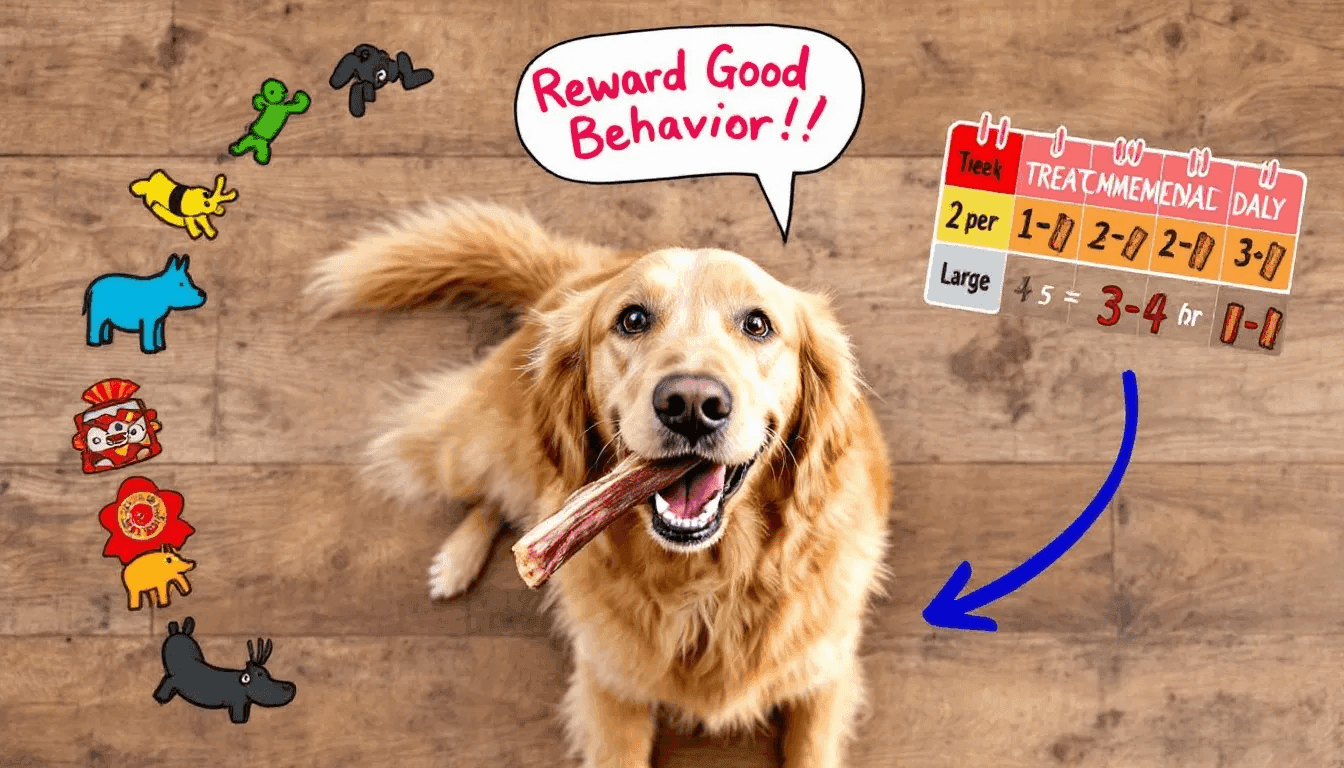Can Dogs Eat Bully Sticks Everyday? Benefits and Risks Explained
Posted by Greg C. on Feb 07, 2025
Can Dogs Eat Bully Sticks Everyday? Here's What You Should Know
Can dogs eat bully sticks every day? While these natural chews are popular and nutritious, daily consumption may lead to health issues. This article will cover the benefits, risks, and recommended frequency of feeding your dog bully sticks.
Key Takeaways
-
Bully sticks are safe for dogs but should be given 2-3 times weekly to avoid excess calories and potential health issues.
-
They offer high protein and essential amino acids, making them a nutritious treat, but they can also pose risks like choking and bacterial contamination.
-
Choosing the right size and thickness of bully sticks is key to ensuring your dog’s safety and enjoyment during chewing sessions.
Are Bully Sticks Safe for Daily Consumption?

Bully sticks are a popular choice for dog chews, but are they safe for daily consumption? These dog chews are made from beef or steer pizzle sticks, and while they’re generally considered a natural and healthy treat, there are some safety concerns to keep in mind. One of the main issues is bacterial contamination, which can risk your dog’s health. Purchasing from reputable companies that adhere to high processing and hygiene standards can mitigate this risk. A clean eating area for your dog also helps minimize contamination risks.
Another factor to consider is the frequency of feeding. Although giving your dog a bully stick every day might be tempting, limiting this treat to two or three times a week is advisable. This is because treats like bully sticks should constitute no more than 10% of your dog’s daily caloric intake. Overfeeding can lead to an unbalanced diet and potential health issues. Thus, bully sticks should complement a balanced diet rather than replace it.
Because of their natural composition, bully sticks are a hygienic alternative to rawhide chews. Unlike rawhide, which can contain artificial chemicals and preservatives, bully sticks are a single-ingredient treat that is often more easily digestible for dogs. However, this doesn’t mean they’re free from risks. Always observe your dog enjoying their bully stick to ensure they’re chewing it safely.
Caloric Impact of Bully Sticks on a Dog's Diet
Knowing how many bully sticks affect your dog’s caloric intake is crucial for maintaining overall health. A 6-inch bully stick can contribute between 54 and 132 calories to a dog’s diet, depending on its thickness and length. On average, bully sticks have a caloric density of about 15 calories per inch. This might not seem like a lot, but for a small dog, it can account for up to 30% of their daily caloric needs.
Many pet owners underestimate the caloric contribution of bully sticks to their dogs’ diets. Feeding your dog a bully stick every day without adjusting their regular food portions can lead to an excess intake of calories, which can result in weight gain and related health issues. Considering the extra calories from bully sticks when planning meals can prevent this issue. Regular food portions should be adjusted to ensure your dog maintains a healthy weight.
Veterinarians often advise considering bully sticks as a source of calories when discussing your dog’s diet. This ensures that the treats are part of a balanced diet that meets your dog's nutritional needs without overfeeding.
Treats should be an occasional indulgence, not a staple of your dog’s diet.
Nutritional Benefits of Bully Sticks

Bully sticks aren’t just a tasty treat for dogs; they also offer several nutritional benefits. One of the most significant advantages is their high protein content. Bully sticks can contain as much as 80% protein, which is essential for supporting dog muscle development. Protein is a crucial component of a dog’s diet, helping to build and repair tissues and maintain a healthy coat and skin.
In addition to being high in protein, bully sticks are rich in essential amino acids. These amino acids are vital in tissue repair and bolstering the immune system. They help keep your dog healthy and resilient against infections and diseases. This makes bully sticks a delicious treat and a functional one that supports your dog’s overall well-being.
Another benefit of bully sticks is their low-fat content. This makes them suitable treats for dogs who need to manage their weight. Unlike other treats high in fat and calories, bully sticks provide a healthier option that won’t contribute to unnecessary weight gain.
When included in a balanced diet, bully sticks can greatly reward your dog while supporting their nutritional needs.
Potential Health Risks
While bully sticks offer several benefits, there are also potential health risks to be aware of. One common issue is digestive problems. Bully sticks can lead to gas and vomiting, especially in a dog’s stomach with sensitive stomachs. Additionally, the richness of bully sticks can cause diarrhea, mainly if your dog isn’t accustomed to them or if they eat too many. Introduce bully sticks gradually to avoid an upset stomach in your dog.
Another significant health risk is bacterial contamination. Bully sticks can harbor harmful pathogens like Salmonella, Clostridium difficile, Staphylococcus aureus (MRSA), and Escherichia coli. These bacteria can cause serious health issues, including stomach upsets, vomiting, and diarrhea. Minimize this risk by buying bully sticks from reputable sources and ensuring proper storage and handling.
When feeding bully sticks, choking hazards and intestinal blockages are also concerns. Small bully sticks or large pieces that break off can pose a choking hazard. These pieces can lead to intestinal blockages if swallowed, which may require surgical intervention. To prevent these risks, supervise your dog while it chews on a bully stick and discard any small or broken pieces.
How Often Should You Give Your Dog a Bully Stick?

Determining how often to give your dog a bully stick can be challenging. However, some pet owners might be tempted to offer this treat daily; limiting bully sticks to once a day is generally recommended. However, adjust the amount based on your dog’s total caloric intake. Treats, including bully sticks, should not exceed 10% of your dog’s daily calories.
Consider giving your dog bully sticks two to three times a week as an alternative treat for variety and balance. This will prevent overconsumption and keep your dog excited about its treats. Rotating between different types of treats can also provide various nutritional benefits and avoid boredom.
Consider your dog’s age, health, and activity level when deciding the frequency of giving them a bully stick. Puppies, seniors, and dogs with specific health conditions may have different dietary needs. Always consult your veterinarian if you’re unsure about the appropriate frequency for your dog’s bully stick consumption.
Monitoring Chewing Time
Monitoring your dog’s chewing time ensures its safety while enjoying bully sticks. This helps prevent your dog from swallowing large pieces, which can pose a choking hazard. It’s advisable to start with short chewing sessions, especially for dogs new to bully sticks. Begin with 5—to 10-minute sessions and gradually increase the time as your dog becomes more accustomed.
Adult dogs typically chew for 30 to 40 minutes daily. Watch your dog closely during these sessions to ensure it chews safely. Remove the bully stick when it becomes small enough to be a choking hazard, usually 2.5 to 3 inches in size. Using holders for bully sticks can also help secure them and reduce the risk of your dog swallowing large pieces.
Another important aspect is the condition of the bully stick. If it becomes overly soft or frayed, it should be discarded to prevent harm. Additionally, always ensure fresh water is available during chewing sessions to aid digestion and keep your dog hydrated.
Monitoring your dog’s chewing time and following these guidelines ensures a safe and enjoyable experience.
Alternatives to Bully Sticks

While bully sticks are a fantastic treat, it’s always good to have alternatives. Raw bones, like hip or femur bones, are packed with marrow and minerals, offering a long-lasting chew. Deer and elk antlers are also durable chews that promote dental health and are rich in essential nutrients. These options can be great for dogs that are aggressive chewers or need a more challenging chew.
Beef hooves are another excellent alternative, providing a long-lasting chew that can be stuffed with treats for enrichment. Fish skin chews offer a nutritious source of omega-3 fatty acids, which benefit your dog’s coat health. Ear chews from pigs or cows are low-fat and suitable for dogs with food sensitivities.
Other options include Himalayan chews, which are gluten-free and typically safe for dogs with sensitive stomachs. Tendon chews are high in collagen, beneficial for joint health, and suitable for dogs of all ages. Sweet potato chews are high in fiber and antioxidants, promoting a strong digestive system. At the same time, frozen carrots provide a low-calorie, all-natural chew option rich in vitamin A. Single-ingredient dog chews are also an excellent choice for pet owners looking for simple and healthy treats.
These alternatives can provide variety and additional health benefits for your dog.
Tips for Choosing the Right Size Bully Stick

Selecting the right size bully stick ensures your dog’s safety and enjoyment. The bully stick should be larger than your dog’s mouth to reduce the risk of choking. Consider your dog’s weight and chewing style when selecting a bully stick. Different breeds and sizes of dogs require specific lengths and thicknesses of bully sticks to match their chewing habits.
The thickness of a bully stick can significantly impact your dog’s chewing experience. Thinner sticks are often more appropriate for smaller breeds, while larger ones might need thicker, more durable ones. Choosing a bully stick that can withstand your dog’s chewing power is also essential without breaking into large, hazardous pieces.
Choosing the right size and thickness ensures your dog gets the most out of their bully stick without compromising safety. This careful selection process helps provide a perfect chew that keeps your dog happy and healthy.
Summary
In summary, while bully sticks can be a delightful and beneficial treat for dogs, they require specific considerations. These include ensuring their safety, understanding their caloric impact, and recognizing potential health risks. Limiting bully sticks to two to three times a week and monitoring chewing time can help maintain your dog’s health and safety. Moreover, exploring alternatives and choosing the right size bully stick can enhance your dog’s chewing experience.
Informed and responsible pet ownership involves making educated choices about your dog’s treats. Following the guidelines, you can ensure your dog enjoys bully sticks safely and healthily. Here’s to happy, healthy, and satisfied pups!
Frequently Asked Questions
Can dogs eat bully sticks every day?
It's best not to give your dog bully sticks every day; sticking to 2-3 times a week is a safer bet for their health.
How many bully sticks can a dog have per week?
Giving your dog 2-3 bully sticks weekly is a good rule of thumb. That way, they can enjoy them without overdoing it!
Are there low-calorie alternatives to bully sticks?
Absolutely! Fish skin chews and frozen carrots make great low-calorie alternatives to bully sticks.
What are the signs of a choking hazard with bully sticks?
If you see large pieces breaking off or the bully stick getting too small, toss it out immediately to avoid choking hazards. Safety first!
How do I choose the right size bully stick for my dog?
To pick the right bully stick for your dog, choose one bigger than its mouth and consider its weight and chewing habits. This will ensure that your dog can enjoy it safely without choking.



